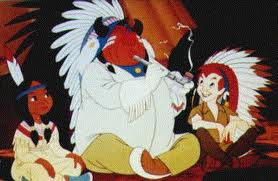In Disney's 1940 film, Pinocchio at the point when Pinocchio and all the other boys arrive at Pleasure Island there is a scene cut from the rough house to a place called Tobacco Row.
Tobacco Row features a number of, what appear to be, early animatronics of First Nations men, all identical. They hold a large pipe at their side and with the other hand they hand out tobacco; cigars, cigarettes, and chew continuously. They shower the boys with this temptation, which is the point of Pleasure Island. Pleasure Island is designed to tempt young boys into behaving poorly, making bad decisions and feeding their temptations so that they will turn into Jack Asses or, if you prefer, donkeys.
"I think that it is far more likely that the animators simply said, tobacco, that reminds me, Indian Braves, lets do that".
Tobacco was and remains an important part of many first Nations Cultures. Traditionally tobacco has been used to pray, give thanks to the Creator and Mother Earth, communicate with spirits, and purify the mind and heal the body. However, the tobacco used in these ceremonies and rituals is much different from the tobacco with high nicotine content and added chemicals that we find in cigarettes, and the high nicotine content of cigars and chewing tobacco. This is not ceremonial tobacco. First Nations elders maintain that this recreational use of tobacco is highly disrespectful to the spiritual, medicinal, and traditional uses of tobacco. Tobacco should be used in a traditional ceremonial pipe for ceremonies.
 |
| Ceremonial Peace Pipe typical of Northern Plains Nations |
 |
| Peter Pan - 1953 |
"We cannot discount that this is a historically accurate treatment for the time period of the film".
Historically residential schools were created for Indian children because white immigrants believed that Indians still had a soul, unlike black African slaves who they believed had no souls. Indians simply had to have the Indian 'beat out of them' so that they could become like the white man. There was much that was unknown about First Nations cultures and this lack of understanding and misunderstanding is still prevalent today. While I would like to think that my previous idea of Tobacco Row as a metaphor is true, I think that it is far more likely that the animators simply said, tobacco, that reminds me, Indian Braves, lets do that.
 |
| Pinocchio - 1940 |
So in this case I have to admit that the Walt Disney company was using racial stereotypes and in turn helped to perpetuate the untrue stereotype of First Nations people as slaves to their vices, incapable of higher morality. However, let me remind you that is was 1940 and, not that I am making an excuse for forgiveness but, things were different back then, people didn't understand and didn't try to understand. They knew what they knew and that was good enough for them. Also, this film takes place in Europe in the mid 1800s where there was a fascination with America and 'Indians' but no one really knew anything about the culture, only stories that had been told third hand so these First Nations stereotypes are not out of character for the time period that the film was set. We cannot discount that this is a historically accurate treatment for the time period of the film.

Is Disney Plus going to add a warning label to Pinocchio?
ReplyDeleteTo Alison, that article about Native Americans was very interesting since I've noticed many old Disney cartoons where Native Americans are depicted as people wearing headdresses and feathers on their head.
In the recent news about Peter Pan given a label warning on Disney Plus. I'm wondering, is Pinocchio going to be subject to a label warning due to the Native American stereotype? Also in the 1995 Disney animated film Pocahontas, will that film be given a label warning due to the subject of racism and mistreatment of Native Americans?
I watched Pinocchio on Disney Plus and it has that exact same scene you showed on your blog picture that was shown in the film, I contacted Disney Plus about that Native American scene in Pinocchio and I have a feeling Pinocchio will most likely be given a label warning since it was made in 1940. Let me know what you think. You should share this article on Facebook and Disney fandom, it's one of the best articles I've ever read.